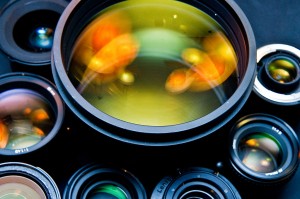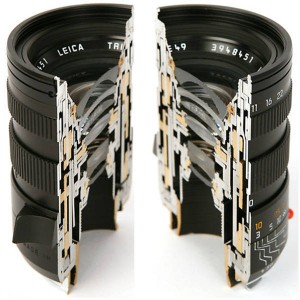
Camera lenses are devices that are made up of an optical lens or multiple lenses aligned in a certain way used with a camera chipset to make what we see everyday with our eyes possible for a camera. There is no major difference between lenses used for still or motion cameras but the detailed design and construction will depend on how far, close, etc the camera will be capable of. Most cameras have a permanent fixed lens built into the camera but some cameras have the ability to connect interchangeable lenses with different focal lengths and other properties. When it comes to construction of the lens the higher quality it gets the less optical obstructions there will be which will give a better quality image. With there being so many different kinds of lenses and qualities, finding the right one for the camera you have is key to having the best image possible.
Construction
Camera lenses are made up of multiple elements that when put together properly will allow the camera not only to see but see clearly. To start the front element is the most important part of its entire lens assembly. Today we help protect that lens by coating it with protective sealant to reduce scratching, flare, reflection, and if need be to adjust color balance. To decrease the chance of a front lens aberration the lens is curved so that the angle of incidence and reflection are as equal as possible. That way if there is an occurrence of a scratch on the lens, It will basically disappear with the reflection. With a fixed lens camera this is an achievable possibility but with zoom it can be a little tricky. The focus on a lens is adjusted by moving the lens assembly further or closer to the image plane or by moving the different elements of the lens assembly. This can be related to you taking off your glasses and moving them further and closer to your eyes. Today, with most cameras, this is done automatically with an assembly called a floating system. As for materials, glass is commonly used as the optics because of its resistance to scratching and good optical properties. There are many other materials that can be used but does not hold up as good or are very costly. With many new cameras they apply multiple coating. Like I mentioned earlier there are some that protect it from getting scratched, and others that protect it from UV lighting. This will help not only the lens last longer but also protect the chipset from any damage. Some lenses will have a mechanical aperture adjustment, usually referred to as an iris diaphragm, which will regulate how much light is allowed to be captured. Lastly there is the shutter which is to regulate the amount of time the light may pass through the iris. In new cameras the shutter does the Job of both.

Aperture and Focal Lengths
The two main things that people look for in a good lens are focal length and the maximum aperture. The purpose for focal length is what determines the magnification of the image that is being captured onto the image plane and the intensity of the aperture. It will also change the perspective of the image. It will not change the main subject that you are trying to capture but it will effect the background. For any given lens system the focal length is what determines the angle of view. The shorter the focal length the wider your field of view is. The maximum aperture of a lens is read using a calculation called a focal ratio represented as a f-number. It is easily defined as the lenses length divided by the effective aperture. So to clear things up the lower the f-number you see on a specific lens, the better quality image it will produce.
Elements of a Lens
The elements of a lens are based off of what is needed for its specific use. It depends on the angle, its maximum aperture, and price point. When a lens is constructed with a wide angle and large aperture it cost a lot to compensate for reflection and any aberrations. This might be a high quality lens but where there is quality there comes high price. For every day cameras like security cameras there has to be a lens that will capture a quality image but sill meet a low price point. This is achieved by compensating on the width of the lens and increasing the f-number. Doing this still gives you a wide image and good lighting but not the best in the business. When talking about the elements what makes a good picture is the type of quality and control the facility has. When the glass is made, if not done right, there could be defects within the glass its self. There could be scratches, bumps, bubbles, fog, etc. Major improvements in the industry today make that a rare incident but still applies.

Conclusion
Camera lenses are delicate devices that when assembled correctly can allow the camera to absorb and capture the world we see everyday. The construction of a cameras lens is very important because one little defect can make all the difference. The use of specific coats placed on the front lens can help with protecting it from abrasions and UV light. The aperture and focal lengths are key things when looking into a camera lens. It is what gives the camera the most light and the widest aspect ratio to get the best view. Having a specific f-number can also change the cameras perspective so to keep the image as life like as possible you want to keep the f-number as low as possible. The different elements of the lens will be the difference between a higher quality lens and poorly constructed plastic lens. But where there is high quality comes high price. For any more information you can call our tech line at 866-573-8878.
